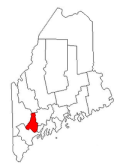Androscoggin County was
formed by act of Legislature passed March
18, 1854, from the counties of Cumberland,
Lincoln, Kennebec, and Oxford. As early as
1606 King James granted by charter the
territory between 84 and 44 north latitude
to parties for the purpose of
colonization. In 1620 James I. divided the
tract embraced in the grand charter of
1606, and granted to the Plymouth Company
in England the portion lying between the
40th and 48th degrees of north latitude.
Sir Ferdinando Gorges was interested in
both of these grants, and in 1622 he and
Capt. John Mason obtained of the Plymouth
Company a grant of the country lying
between the Merrimac and Kennebec Rivers.
These partners divided their possessions
in the territory granted, Gorges taking
that part lying east of Piscataqua River.
Other parties received grants from the
Plymouth Company and the King, which,
owing to the imperfect geographical
knowledge of the country granted,
overlapped each other, and gave rise to
many harassing disputes and conflicts as
to title and jurisdiction. Upon the
division by the Plymouth Company of their
patent among their different proprietors,
the portion lying between the Piscataqua
and Kennebec Rivers was awarded to Gorges
in 1635, and confirmed to him by King
Charles I. in 1639. Gorges died in 1647,
and his heirs maintained their claim to
this grant till Massachusetts extinguished
it by purchase in 1677. The territory
within the limits of Androscoggin County
was first nominally embraced within the
judicial bounds of York County till June
19, 1760, when Cumberland and Lincoln
Counties were formed, the boundary between
which was the Androscoggin River north of
where it enters the county as now bounded
on the south. February 20, 1799, Kennebec
County was formed from the northern part
of Lincoln, with a boundary including
Greene, Wales, Leeds, and East Livermore
within its limits. March 4, 1805, Oxford
County was established from northern parts
of Cumberland and York, with a boundary to
include Turner and Livermore. The
southwestern portion remained with
Cumberland till Androscoggin County was
formed, as before stated, in 1854, taking
as follows: Auburn, Danville, now the
southern portion of Auburn, Durham,
Poland, and Minot from Cumberland;
Livermore and Turner from Oxford; East
Livermore, Greene, Leeds, and Wales from
Kennebec, and Lewiston, Webster, and
Lisbon from Lincoln Counties. In area
Androscoggin is the smallest county in the
State except Sagadahoc, containing eleven
towns and two cities. The location of a
shire town at incorporation was left to
vote of the inhabitants, but restricted to
be within the corporate limits of Lewiston
Falls Village, which embraced adjoining
portions of the three towns of Lewiston,
Auburn, and Danville. Auburn was selected,
and a fine set of county buildings of
brick with granite basement was erected in
1856 and 7 at a cost of $100,000. The
population of the towns comprising the
county was in 1830, 19,851; 1840, 22,532;
1850, 25,748; 1860, 29,743; 1870, 35,870.
The valuation of estates in 1850 was
$4,152,502; 1860, $8,230,892; 1870,
$17,592,555. These figures show a
prosperous growth in both wealth and
population.
Before the white man came to this part of
Maine the Anasagunticook or Androscoggin
Indians peopled the valley of the river
that takes their name, cultivating its
rich intervals, fishing in its sparkling
waters, and hunting in the dense forests
that spread away on either bank. From one
of its chiefs, Worumbee, the Indian title
to a large part of the land in the county
was obtained, as a reference to town
histories will inform the reader.
The general surface of the county is
moderately uneven. While it boasts no
mountain ranges, numerous elevations of
sufficient height, are found to command
many charming views of rural scenery. The
Androscoggin River traverses the county
from north to south nearly through its
centre, and that, with its tributaries and
the numerous ponds with which they are
connected, water it amply and furnish good
and abundant powers for manufacturing
purposes. By a reference to the town
histories the extent and kind of
manufactures may be gathered. The soil in
the main is fertile, repaying well the
intelligent farmer for the labor and
capital invested in its culture. The value
of its agricultural productions, as given
by last census, may be found in the
statistical table placed in this work, to
which the attention of the reader is
invited. In the early settlement of the
county lumbering was the leading pursuit,
followed as the forests disappeared by
agriculture; but of late years
manufacturing under the fostering care of
State enactment and the improvement of
water powers has largely attracted
capital, and its productions are now
counted by millions, exceeding in value
those of any other industry in the county.
The shipping facilities are wholly by
rail. The Maine Central, with its
Divisions, passes through the cities of
Lewiston and Auburn, and the towns of
Lisbon, Webster, Wales, Greene, Leeds, and
East Livermore; the Grand Trunk
accommodates the southwestern part of
Auburn, and traverses Poland and Minot;
and the Portland and Oxford Central,
connecting with the Grand Trunk at
Mechanic Falls ,passes through the western
part of Minot; while the Lewiston and
Auburn road, now in process of
construction, connects these two cities
with the Grand Trunk. Few counties in the
State are so well supplied with railway
communications as Androscoggin; three
towns only in the county but have a
railroad passing through them. These iron
pathways link interests and give birth to
enterprises that are felt in every hamlet
in the land.
In judicial affairs the county belongs to
the Western District, so called. An annual
session of the Supreme Judicial Court, as
a court of law, is held at Portland on the
third Tuesday of July for this District.
Nisi Prius terms for the county are held
at Auburn on the third Tuesday of January,
April, and September, civil and criminal.
Terms of the Probate Court are held at
Auburn on the third Tuesday of each month.
The County Commissioners hold their
regular sessions the first Tuesday of
April and October
Politically, Androscoggin belongs to the
Second Congressional District. In State
affairs it belongs to the Fourth District,
and is entitled, under last apportionment,
to two senators and nine representatives,
distributed as follows: Turner and
Livermore one; Lewiston three; Auburn two;
Leeds, East Livermore, Greene, and Wales,
one; Webster Durham and Lisbon, one;
Poland and Minot, one.
A commendable interest is taken in the
cause of education. A young but
flourishing college, centrally located,
opens its doors to those seeking higher
attainments than can be given at the
public schools, while everywhere
throughout the county the common school
receives the sympathy and earnest support
of the inhabitants.
Source: Atlas and
History of Androscoggin County, Maine,
by Sanford Everts & Co., published in
1873, page 94.
Contributed 1 Nov 2024 by Norma Hass
|


